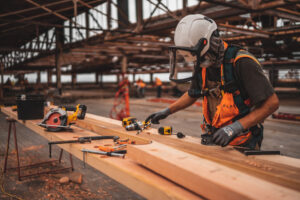8 Ways To Build Collaborative Construction Teams

Collaborative Construction Teams are essential to a healthy and productive work environment.
Getting your construction team working collaboratively is one of the most important parts of running a construction project. Without clear construction workflows and processes, projects will experience delays and quality issues. Disputes will arise, work will have frequent stops, and change orders will ensue.
A collaborative construction team on the other hand, can bring everyone together and streamline the work. If everyone’s expectations are set upfront, then projects can flow much more smoothly. Schedules will be more likely to stay on track, and any unforeseen issues will be more quickly mitigated.
The collaborative construction team is a unit that pools its resources and knowledge, shares the same goals, and works together towards achieving that goal. In a successful collaboration, every member coordinates, cooperates, and works towards building a good association based on mutual trust and respect.
Here are eight ways construction managers, foremen, project managers, and executives can help foster collaboration among their various construction teams.
Clear Contracts
For professional work, the contract defines the relationship. It spells out the terms of the agreement, the work that’s to be done, and the compensation that’s going to be paid for it. The more detailed and clear the contract is, the more likely the relationship will end up on a successful path. Specific details that are important to include are deliverables, schedule, scope of work, change order / claims clauses, and dispute resolution terms. The contract should include all the foreseeable possible outcomes that may occur throughout the course of the project. Ideally all projects will run on schedule and without hiccups. But in construction, this isn’t always the case. A great many projects take more work than expected due to discoveries made during the course of the project. Ensuring all potential outcomes are clarified in the contract is the first step to having a successful, collaborative construction team.
Schedule Clarity & Visibility
Communicating the schedule to each contractor and team is paramount to successful collaboration. Knowing when each contractor and subcontractor is supposed to show up and complete various milestones will help maintain a smooth construction workflow. It’s useful if contractors know both their specific schedules, and how they fit into the greater schedule for the project. This can give a sense of meaning to their work and compel them to not only finish their job, but foster a teamwork mentality.
Resource Planning
Each stage of the project relies on plans, permits, materials, equipment, crew, and other resources. These require extensive planning to ensure all the right resources are in place when the construction crews are ready for them. Agreements need to be put in place long in advance to ensure equipment is allocated, access roads are cleared, permits are up to date, materials are purchased and transported on site, and contractors are available. The planning involved around gathering all the resources to the right location can be more work than the actual job at times.

Leadership of Collaborative Construction Teams
Installing the right leadership team can be the make it or break it for construction projects. They need to be experienced, have clear communication, be able to establish a positive culture for the crews, and have a thorough knowledge of the construction process. Construction managers need to be able to lead people and establish discipline and quality control across every aspect of the project.
Team Building
Putting the right team together means more than gathering those with the requisite skill sets and placing them on a team. Group compatibility needs to be considered. If one construction crew is known to have a rival relationship with another, then depending on the situation, measures should be made to keep them apart. The ideal is selecting people based on preexisting relationships, since they have some rapport in working together. Depending on the project size it’s important to encourage relationship building by having happy hours, company provided lunches, and similar events. A little bit of giving upfront can go a long way in paving the way to successful collaborative relationships.
Clear Communication Processes
Construction projects are destined to end up with change orders. As soon as you get out on the actual jobsite, you’ll immediately find things aren’t the same as is represented in the plans. Contractors may dig a hole and hit bedrock before they expect, or utility lines may not be where the plans indicate they should be. There’s any number of situations that may arise that affect the overall budget and schedule of the construction project. Establishing a change order and RFI process early can mitigate many situations down the road. There’s also normal day-to-day communication that needs to be established, such as Monday 6AM meetings among foremen, project managers, and other leaders. Keeping everyone on the same page at all times with the current status of the project, is essential.
Have a Quality Inspection Plan
Every aspect of the project needs to be inspected by the owner’s team. Contractors’ work needs to be reviewed before they build the next level. These checks include ensuring they did the job to spec, and also measuring things like settlement of buildings, concrete strength, and other relevant construction metrics. Part of collaboration on construction projects is putting in place checks and balances to ensure the work being completed is high quality.
Construction Communication Software
In today’s construction sites, larger construction projects can’t work well without construction management software. These platforms unite all aspects of construction projects so the construction workflows work seamlessly together. From teams, to equipment, crews, scheduling, dispatch, sales & bidding, contracts, quality, and more, Construction Management Software ties it all together to have real-time collaboration. Offices can communicate in real-time with the field, plans can be marked up and updated so everyone has access to the latest versions. Documents can be stored in a centralized place so anyone can access them.
You can find a full list of leading construction management software apps here, including Linarc’s newest offering that helps crews around the world stay in sync.
How to build collaborative construction teams?
Good collaborative construction teams are not just about everyone completing their tasks on schedule. It is about all the stakeholders coming together into a strong relationship built on trust and respect. Efficient collaborations require careful planning, coordination, and involvement of all parties in the project.
Here are some steps to building strong collaborative construction teams.
- Define clear contracts
A contract spells out the terms of the agreement, the work to be done, and the compensation. Include specific details in the contract and all the possible foreseeable outcomes that may occur throughout the project. Some essential information includes deliverables, schedule, the scope of work, change orders/claims clauses, and dispute resolution terms.
- Ensure schedule clarity and visibility
Communicating the schedule to each contractor and subcontractor will help maintain a smooth construction workflow. If collaborating teams know their specific plan and how they fit into the project, it helps the teams complete the milestones and develop a teamwork spirit.
- Careful resource planning
A project relies heavily on extensive planning to be successful. A manager needs to ensure equipment is allocated, permits are up to date, materials are purchased and transported on-site, and contractors are available. Collaborative teams can work effectively when all the right resources are in place.
- Choose the right leader for the teams
Right construction managers lead people and establish discipline and quality control across the projects. The leader must be experienced with thorough knowledge of the construction process, set clear communication lines, and motivate the collaborative teams.
- Build rapport among collaborative construction teams
It is vital to encourage relationship building among teams. Having the right team with the requisite skill sets to work together can lead to successful collaborative relationships.
- Establish clear communication processes
Change orders are common for any construction project. Mishandling these can result in delays and cost escalation. Establish a change order and RFI process early to mitigate any situation affecting the construction project’s budget and schedule. Having clear and available communication lines will keep everyone updated and on the same page.
- Have a quality inspection plan
A project manager must put checks and balances in place to ensure the work completed at every stage of construction is high quality. Review the contractors’ work before they build the next level for quality specifications and other relevant construction metrics.
- Use construction communication software
Construction projects need construction management software to unite all aspects of projects so the teams can work seamlessly together. The software ties teams, equipment, crews, scheduling, dispatch, sales & bidding, contracts, quality, and documents in one centralized place for real-time collaboration.
Building a robust collaborative construction team is challenging, but by following these best practices, you can create teams that connect better and are more productive.
Conclusion
Building a collaborative construction team is challenging, and no two projects are the same. By following these best practices you’ll be more likely to foster a culture where teams come together and work through things as they come up, and for people to be happier, better connected, and more productive.
How do you building a collaborative construction team? Tell us about it here.




